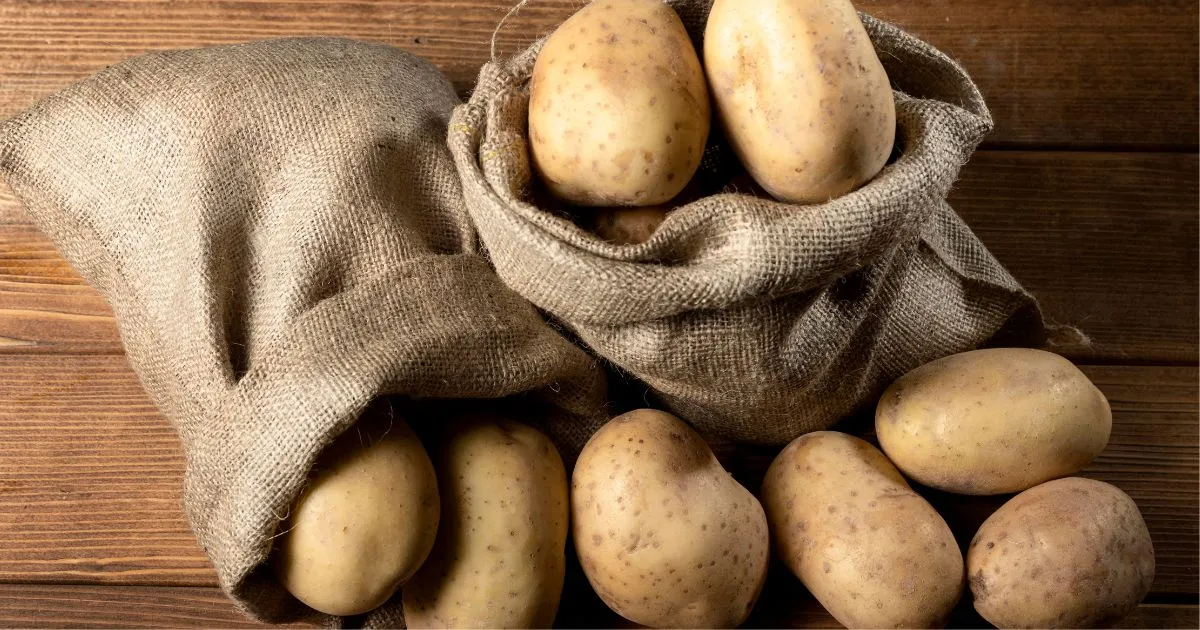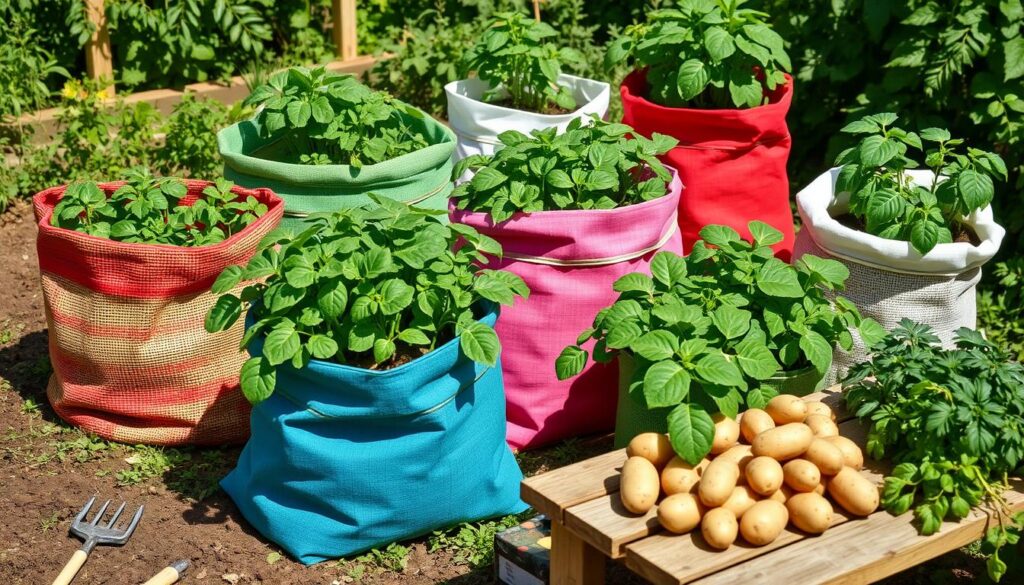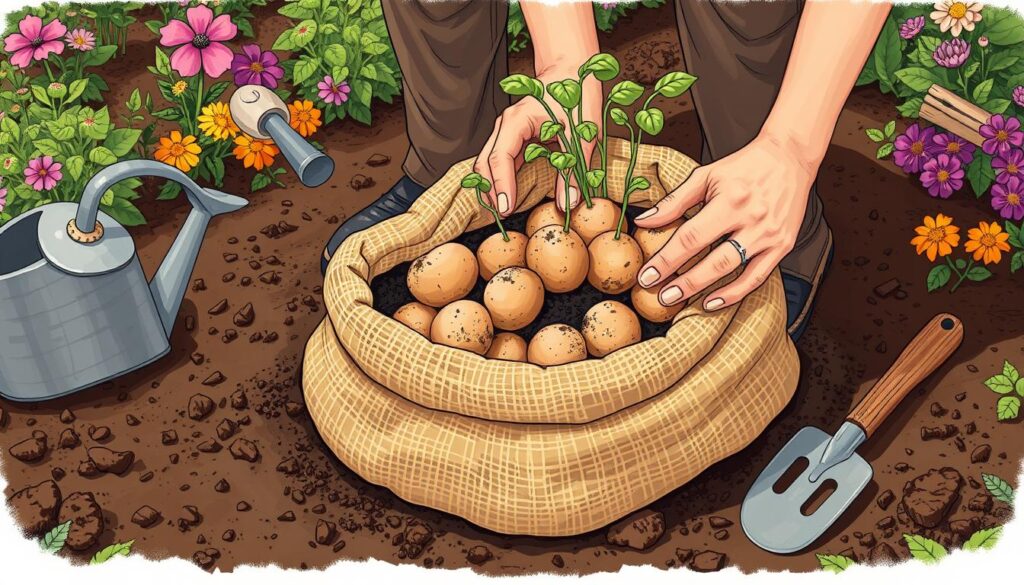Blog
Growing Potatoes in Bags: Easy Container Gardening Guide

Discover the joys of growing potatoes in bags. It’s a space-efficient and rewarding way to garden, perfect for city folks and those with little outdoor space. In this guide, you’ll learn how to grow potatoes in grow bags. You’ll get fresh, homegrown produce right at your fingertips.
Table of Contents
Why Container Gardening Is Perfect for Growing Potatoes
Potato bagiculture, or growing potatoes in sacks, is a hit with urban gardeners and those with little outdoor space. This method of container gardening has many benefits. It makes growing potatoes in sacks a great choice for these versatile tubers.
Space-Saving Benefits for Urban Gardeners
One big plus of growing potatoes in bags is saving space. Traditional potato patches take up a lot of room. But, potato sacks let you use your space better, whether it’s a balcony, patio, or small backyard. This makes bag potatoes perfect for those with little outdoor space.
Controlled Growing Environment Advantages
Another plus of growing potatoes in sacks is the controlled growing environment. Containers help you manage soil, moisture, and protect against pests and diseases. This is harder to do in a traditional garden. It leads to healthier, more productive potato plants.
Mobility and Flexibility Benefits
The ability to move potato sacks is also a big plus. You can move them to follow the sun, adjust to weather changes, or bring them inside when it’s cold. This flexibility helps you grow better potatoes and harvest them longer.
By using growing potatoes in sacks, urban gardeners and those with little space can grow their own potatoes. It’s great for saving space, controlling the growing environment, and being flexible. Container gardening is a smart choice for growing potatoes.
Essential Materials and Equipment for Growing Potatoes in Bags
Growing potatoes in bags or containers needs specific materials and tools for a good harvest. Whether you’re starting with sack potato growing or are already into containerized potato growing, knowing what you need is key. It helps you start off right.
The bags themselves are crucial for growing potatoes. You should choose best potato growing bags made for container gardening. They should be durable, breathable, and have lots of holes for drainage to avoid waterlogging.
- High-quality fabric or burlap grow bags
- Potting soil or a custom soil mixture
- Seed potatoes
- Trowel or small shovel
- Watering can or hose
- Organic fertilizer
You’ll also need a good soil mix for your potato plants. A mix of potting soil, compost, perlite, and topsoil works well. Don’t forget a trowel or small shovel for planting and harvesting. And a watering can or hose to keep your plants watered.
With these essential materials and tools, you’re ready for a successful sack potato growing or containerized potato growing journey. You can grow your own potatoes in bags, even with limited space. It’s convenient and flexible.
Selecting the Best Potato Varieties for Container Growing
Choosing the right potato varieties is key for growing potatoes in bags or sacks. Potatoes vary in maturity and growth habits. The right types can greatly impact your harvest. Let’s look at the best early, mid, and late-season varieties for container gardens.
Early Season Varieties
Early-season varieties are great for those who want to taste homegrown potatoes first. They mature in 60-90 days. Here are some top picks for planting potatoes in bags:
- Yukon Gold: A classic early potato with a buttery, yellow flesh and a delicate skin.
- Red Norland: An early red-skinned variety with a creamy, white interior.
- Red Bliss: A vibrant red-skinned potato with a firm, waxy texture.
Mid-Season Potatoes
Mid-season varieties offer a longer harvest window. They mature in 90-120 days. Here are some mid-season options for how to grow potatoes in sacks:
- Kennebec: A versatile, all-purpose potato with a white flesh and a light, fluffy texture.
- Russet Burbank: A classic baking potato with a golden-brown skin and a light, fluffy interior.
- Purple Majesty: A vibrant purple-skinned potato with a dense, creamy flesh.
Late Season Options
Late-season varieties are great for a longer harvest and better storage. They take up to 120 days to mature. They also have a robust, earthy flavor. Here are some late-season options for your planting potatoes in bags:
- Adirondack Blue: A stunning blue-skinned potato with a dense, creamy texture.
- German Butterball: A buttery-yellow potato with a rich, nutty flavor.
- Mountain Rose: A red-skinned potato with a unique, slightly sweet taste.
By choosing a mix of early, mid, and late-season varieties, you can ensure a successful container garden. You’ll enjoy a bountiful harvest all season long.
Choosing the Right Growing Bags and Containers
Choosing the right growing bags or containers is key for growing potatoes in containers. Potato grow bags and burlap sacks are great for those with little space. They are perfect for urban and small-space gardeners who want to grow their own potatoes.
Potato grow bags come in sizes from 5 to 20 gallons. They are made of breathable fabric, allowing for good drainage and air. Burlap sacks are a natural choice for planting potatoes. They keep the soil aerated and can be moved easily in the garden.
| Potato Grow Bags | Burlap Sacks |
|---|---|
| Breathable, fabric containers | Natural, sustainable option |
| Excellent drainage and air circulation | Porous structure for well-aerated soil |
| Typically 5-20 gallon capacity | Easy to move around the garden |
When picking growing bags or containers, think about space, yield, and your gardening style. Potato grow bags and burlap sacks are great for growing potatoes, even in small outdoor areas.

“Growing potatoes in containers is a game-changer for urban and small-space gardeners. The right growing bags or sacks make it easy to cultivate a bountiful potato harvest.”
Soil Requirements and Preparation Techniques
Growing potatoes in containers or grow bags needs the right soil. The soil mix must have the right nutrients, pH balance, and drainage. This is key for your potato plants to grow well.
Optimal Soil Mix Components
The best soil for growing potatoes in containers is well-draining and full of nutrients. You can mix the following to create the perfect soil:
- High-quality potting soil or compost
- Perlite or vermiculite for better drainage and air
- Aged manure or bone meal for nutrients
pH Balance and Nutrients
Potatoes do best in slightly acidic soil, with a pH of 5.0 to 6.5. You might need to add sulfur or lime to get the right pH. Also, a slow-release fertilizer can give your potatoes the nutrients they need.
Drainage Considerations
Drainage is very important for growing potatoes in bags or containers. The soil should not stay wet, as this can cause rot and slow growth. Make sure your containers have good drainage holes. Or, use a potting mix with perlite or vermiculite to help with drainage.
“Paying close attention to the soil requirements and preparation techniques can make all the difference in the success of your container potato farming endeavors.”
Step-by-Step Guide to Planting Your Potato Bags
Planting potatoes in grow bags is easy and can lead to a big harvest. Here’s how to get your potato bags ready for a great crop:
- Prepare the Seed Potatoes: Cut your seed potatoes into pieces, making sure each has at least one eye. Let them dry for a day or two before planting.
- Fill the Grow Bag: Put a 2-3 inch layer of soil mix at the bottom of the bag. Press it down to make a flat surface.
- Plant the Seed Potatoes: Place the seed potato pieces, cut side down, 12 inches apart in the bag. Cover them with 4-6 inches of soil.
- Water Thoroughly: Water the soil in the bag until it’s moist but not too wet.
- Maintain Soil Depth: As the plants grow, add more soil to the bag. Keep the tubers covered and away from sunlight.
By following these steps, you’ll be on your way to a big harvest of homegrown potatoes. Happy planting!

| Potato Variety | Planting Depth | Spacing | Days to Maturity |
|---|---|---|---|
| Early Season | 4-6 inches | 12 inches | 70-90 days |
| Mid-Season | 6-8 inches | 15 inches | 90-110 days |
| Late Season | 8-10 inches | 18 inches | 110-130 days |
Remember, the key to growing potatoes in bags is the right soil depth and spacing. This table helps you choose the best for your how to plant potatoes in a potato bag project.
Proper Watering and Moisture Management
Keeping the right moisture levels is key for growing potatoes in bags or sacks. Whether you’re growing bag potatoes or sack potato growing, a consistent watering schedule is crucial. Also, watching the soil moisture closely can greatly impact your harvest.
Watering Schedule Tips
Potatoes need steady moisture from start to finish. Water your potato bags or sacks every 2-3 days, giving them 1-2 inches of water each time. Change how often you water based on your area’s weather. You might need to water more in hot, dry weather and less in cooler, wetter times.
Moisture Monitoring Methods
- Check soil moisture by sticking your finger into the growing container. It should feel damp but not wet.
- Get a soil moisture meter for accurate readings. The ideal moisture is between 50-70%.
- Watch for wilting or droopy leaves, which mean it’s time to water again.
Proper watering and moisture management are essential for a good bag potatoes or sack potato growing harvest. By following these tips, your potato plants will get the water they need to grow well.
Fertilizing Schedule and Nutrient Requirements
Keeping a good fertilizing schedule is key for growing healthy potatoes in bags. Potatoes need a steady supply of nutrients as they grow. You’ll need a plan that meets the needs of growing potatoes in containers.
You can pick from organic or synthetic fertilizers. Organic options like composted manure or kelp extracts release nutrients slowly. Synthetic fertilizers give a quick boost but need careful use to avoid too much.
It’s important to fertilize regularly. Feed your potatoes every two to four weeks. Adjust this based on your plants’ needs and their growth stage. In the early stages, use a mix of nitrogen, phosphorus, and potassium. Later, focus on potassium to help with tuber growth.
FAQ
What are the benefits of growing potatoes in bags?
Growing potatoes in bags saves space, especially for city gardeners. It also offers a controlled environment and more flexibility. You can grow potatoes in small outdoor areas. This method helps you manage soil, moisture, and other conditions better.
What materials and equipment do I need to grow potatoes in bags?
You’ll need growing bags, a good soil mix, seed potatoes, and basic tools. The bags should drain well and be big enough for the plants to grow.
What are the best potato varieties for container gardening?
Choose early, mid, and late-season potatoes for container growing. Early varieties like ‘Yukon Gold’ and ‘Red Norland’ grow fast. Mid-season ones, such as ‘Kennebec’ and ‘Russet Burbank,’ take longer. Late-season potatoes, like ‘German Butterball’ and ‘All Blue,’ need more time but yield more.
How do I prepare the soil for growing potatoes in bags?
The soil should drain well, be rich in nutrients, and have the right pH. Mix compost, peat moss, and vermiculite or perlite for the best mix. Check the soil’s nutrients and add organic fertilizers as needed.
What are the key steps for planting potatoes in bags?
Start by cutting seed potatoes into pieces with at least one eye each. Place them in the bag, about 12 inches apart, and cover with 4-6 inches of soil. Add more soil as the plants grow, keeping the tubers covered.
How do I properly water and manage moisture for container-grown potatoes?
Keep the soil moist but not too wet. Use a watering schedule to maintain consistent moisture. Check the soil with your finger or a moisture meter to know when to water. Good drainage is key to avoid waterlogging and root rot.
What fertilizer schedule should I follow for potatoes in bags?
Potatoes in containers need specific nutrients. Use a balanced, slow-release fertilizer at planting time. Add more every 4-6 weeks. You can also use water-soluble fertilizer in your irrigation water for steady nutrients.
One thought on “Growing Potatoes in Bags: Easy Container Gardening Guide”
Comments are closed.